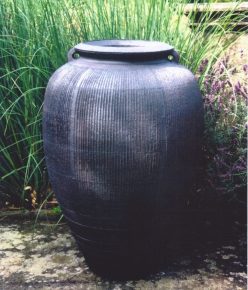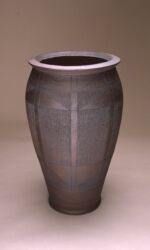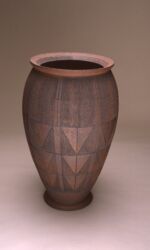A LIFE IN CERAMICS
My life as a potter began at Dartington Hall School. It was here in my gap year before university, that I ventured into the school pottery studio and began to learn to throw.
Ceramics had to take a back seat during my university years, spent studying the history of art at the Courtauld Institute. But already I had felt the pull of working with clay. I managed to join an evening class at Camberwell School of Art. Here I encountered a potter who had a profound influence on my thinking, Lucie Rie. She had developed an approach that kept all of the textural qualities that derive from hand-wrought clay but with precise formal control and refinement.
On graduation I was able to take up pottery again at the then Central School of Arts and Crafts. Here I was encouraged to explore the sculptural and the abstract. I began to develop my work away from tableware – at least in the everyday sense. In fact the first works that I was satisfied to exhibit (at Primavera, Chelsea) were small bowls and jars made in porcelain, a more fluid medium than stoneware, that enables the potter to achieve delicacy (and fragility) of form.
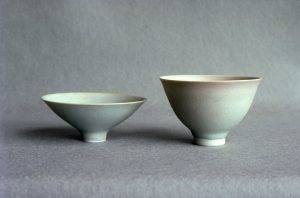
A chance invitation from a friend to make a large pot for her garden gave me the opportunity to work on a far bigger scale than I had considered before. However, this meant mastering a new material and a new technique. To stand outdoors the clay body has to be tough and durable and over the years I have developed a heavily grogged body that when fired to high stoneware temperatures, is particularly strong. From now on my large pots would be made by coiling, a traditional technique that is particularly suited to work of this size.
Images from ancient civilisations were important sources of inspiration. I think of the smooth, black basalt sculptures of the Egyptians with their delicate details scribed lightly into the massive forms. Equally striking were the giant pithoi used for the storage of grain or oil, especially those great Cretan storage vessels that I saw preserved at Knossos. These great jars set in the open among the ruins made me aware of the impact and depth of expression in pots of this scale. Also important was the indigenous pottery of West Africa, where rounded forms are enhanced by a variety of incised and raised geometric decoration.
I began to think of what might be done for our own time. In particular I wanted to use these ancient traditional techniques in a new and contemporary manner, one that would be appropriate for the architecture and landscaping of the present day.
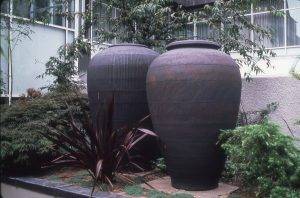
Using my heavily grogged clay and coiling the pots slowly in order to allow each new section to dry sufficiently to support the weight I could build pots up to nearly two metres high. To enhance the form of each pot I incise a geometric pattern directly into the leather-hard clay, so that the scored lines become part of the body of the pot. Drawing into the coarse textured clay like this raises a fine burr of clay along the lines that catches the light and gives the form an extra sense of three-dimensionality.
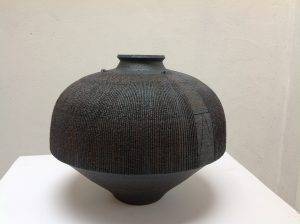
In this way scoring may emphasise the character of the form – the curve of a shoulder for example – or draw attention to a change of plane. It may be an overall textural element or it may create a specific geometric pattern that relates to the form. Pattern emerges when vertical divisions intersect horizontal banding and these units can be further refined into a geometric design – for example chevrons – that alternate or repeat around the pot.
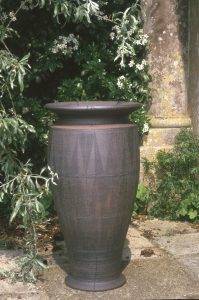
Small vestigial lugs on the shoulder of some of the more recent pots may be distant allusions to their original source in objects of utility. They hint at the possibility that string or rope was used to tie down a lid when such vessels were once used for storage. In my own work I use them to enhance the readability of the scoring patterns, aligning them with the major vertical sub-divisions.
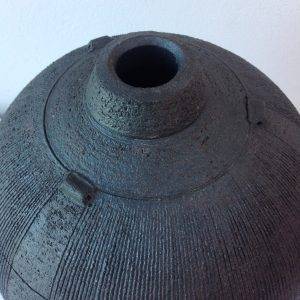
The texture of the clay surface that results from the scoring is important. For this reason I have never been entirely happy with glazes, which would smother and even obscure it. Instead I have developed a technique of brushing metallic oxides into the surface. When taken to high temperatures these burn into the pot and become part of it rather than a skin on it. By varying the mix of metal oxides a range of colours from a deep purple black to a burnt sienna red are fused into the surface to be picked up by the scoring.
In recent years I have carried over the aesthetic of this world into small works intended for indoors. Today I feel happy to work at both scales. Large or small, what is important to me is the achievement of a strong sculptural presence in each individual piece. Coiling is a slow process. Days (and in the case of the largest pots, weeks) elapse while the form takes shape. Prolonged contemplation during this period of waiting enables the final image to solidify in the mind and I can make those innumerable tiny adjustments that give the form its authority.
But the struggle for a reconciliation of precision with solidity and scale, which has driven my work from its earliest days, does not end. Whatever the scale, each pot is a new beginning.

